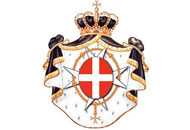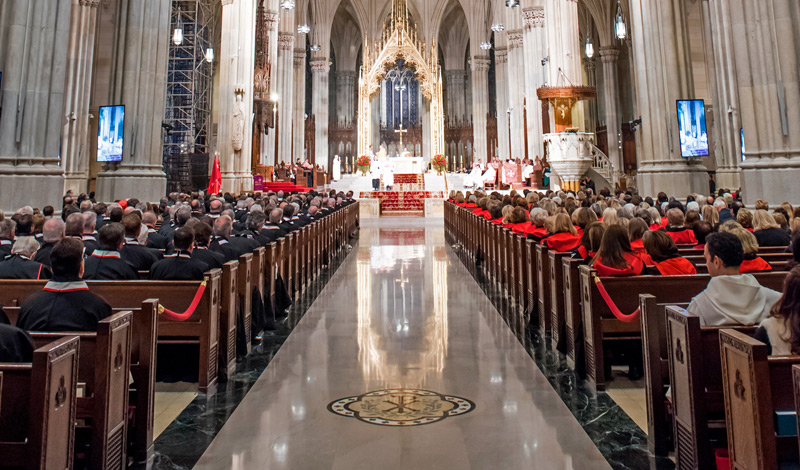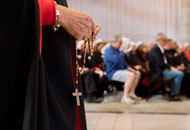Order of Malta
- About The Order
-

About the Order The Sovereign Military Hospitaller Order of Saint John of Jerusalem of Rhodes and Malta is one of the oldest institutions of Western and Christian civilization. The 13,500 Knights and Dames remain true to its principles – nurturing, witnessing and protecting the faith and serving the poor and the sick.
- The Order
- Seat in Rome
- Grand Master
- Organization Chart
- Permanent Observer Mission
- The Magistral Library
- International News
- Other U.S. Associations
- Other National Institutions
-
- American Association
-

The American Association Founded in 1927 as the first association of the Order of Malta in the Americas, the association is headquartered in New York City with over 2,000 Knights, Dames and volunteers in over 30 Areas working with the poor, sick, and incarcerated and giving witness to the Catholic faith.
- History
- Leadership
- Membership
- Finances
- Auxiliary/Associates
- Year of Formation
- Area Web Sites
- Latest News
- Spirituality
-

Spirituality Knights and Dames join the Order of Malta to pursue their spiritual growth over a path laid out by Blessed Gerard more than nine hundred years ago, seeking to nurture and witness the Faith and assist the sick and the poor.
- Daily Prayer of the Order of Malta
- Daily Readings and Reflections
- Saints and Blesseds
- Spiritual Outreach Calls
- Chaplains’ Corner
- Subpriory of Our Lady of Lourdes
- Association Retreats
- Fall/Winter Spiritual Initiative
- Spirituality In Action
-

Spirituality in Action Members are involved in hands-on work at over 100 hundred organizations, including food banks, hospitals, pregnancy support centers, homeless shelters and mentoring programs for at risk children.
- Prison Ministry
- Overview
- Lourdes Pilgrimage
- Pilgrimage for Life
- Wisconsin Pilgrimage
- Respect Life
- Annual Investiture
- Area Grants Program
- Association Newsletters
- Calendar & Events
- Donate Now
-
Donations & Payments You can make a donation, pay your Annual Contribution as a member, purchase a Mass Card, register for AmazonSmile, and more. Be sure to review the Association’s Privacy Policy and Account Agreement.
- Donations & Payments
- Privacy Policy
- Account Agreement
- Mass Cards
- Called to Serve
- Contact Us
-
- Home / Members Only /
Area Leadership Resources / Robes/Capes and Decoration Guidelines
ROBES/CAPES AND DECORATIONS
Information for Areas regarding Appropriate Usage and Etiquette of Robes/Capes and Insignia (Decorations)
Many members of our Order have questions about when, where, and how they should wear their Robes/Capes and Insignia (Decorations) of the Order. The following is meant to be a practical guide for you and your area. Any member who has a question not addressed below are encouraged to contact their Area Chair who can work with the American Association leadership team to provide further clarification.
ETIQUETTE OF ROBES AND CAPES
The Robes and Capes of the Order are Liturgical Garments, reserved specifically for liturgical functions, and ancillary events of requisite dignity.
When and where should Robes and Capes be worn?
The Robe and Cape are worn at official meetings of the government and administration of the Order. These meetings include:
- Chapters General
- Councils Complete of State
- Meetings of the Sovereign Council
Robes and Capes are worn at official spiritual events of the Order, when the Order is participating as a group and at the invitation of the host of the event including:
- Pilgrimages
- Lourdes
- Champion
- Pilgrimage for Life
- Retreats
- Days of Recollection
- Order-specific Masses
- Patriotic Rosary
Robes and Capes may also be worn while participating in an official Church event such as a Red Mass, Blue Mass, installation of a Bishop, funerals, and other official Church events confirmed by your Area Chair. Area Chairs should confirm permission for such events with their area Bishop.
Regarding funerals for Members of the Order—Please see below Q&A as well as the Order’s website governing the Protocols for Wakes and Funerals by clicking here.
When in doubt about the appropriateness of wearing your Robe or Cape, questions should be directed to your Area Chair. Your Area Chair can coordinate with our New York office staff if there is a question about an event.
Can I wear my Robe/Cape as an individual member at different functions?
No, it is not appropriate for an individual member to wear their habit in a congregation or assembly apart from the group, or to wear the habit while alone in public. This includes personal events such as Weddings, First Holy Communions, Confirmations, etc.
Special Note: When you are on your way to an event where Robes/Capes are to be worn, you are not to wear your habit to the event, but you are to hand carry your habit into the venue where a vesting area is to be designated.
Do I wear my Robe/Cape while volunteering or at service events?
Our habit must be practical for the discharge of the physical duties of the religious.
The Order of Malta prescribes work uniforms for activities for which the religious habit would be inappropriate. This would include pilgrimages to Lourdes, Champion, and when serving as a group on behalf of the Order. Theses uniforms are imbued with similar disposition toward piety, simplicity, humility, and witness to the Faith and the Charism of the Order. They should be worn with due consideration for the dignity of the proceedings.
Should I Wear My Robe or Cape to a Funeral of a Member of the Order?
Members planning to attend a funeral of a deceased member should speak with the family regarding whether or not they would like the members in attendance to wear their robes or capes. Whatever is suitable should be determined by the Area Chair, or a designated member.
If members choose to attend in their robes or capes, someone must secure for them a private vesting area. Please consult the undertaker about the cloakroom facility during the wake.
Can a Deceased Member of the Order Be Buried in their Robe or Cape?
Deceased members of the Order can be buried in their robe or cape, but NOT their decorations. Family members also have the option to keep the robe or cape and decorations in remembrance of their loved one, if they choose. However, these items should not be discarded, sold, or donated. Please contact the NY Office if these items are unwanted.
What Should an Individual Do with Old Robes and Capes and Decorations?
Members who resign, Members who move up to Obedience, and family of deceased members should contact the New York Office if these items are no longer wanted. Again, these items should not be discarded, sold, or donated
Can I give to family members/new members?
Official process needed and confirm alignment with process for deceased members.
Emphasize no selling; but gifting if approved. If approved and given as a gift, do second-hand robes and capes need a new blessing?
ETIQUETTE OF ORDER INSIGNIA: WHAT IS FORMAL, INFORMAL, AND CASUAL DRESS?
The Insignia and Cross of the Order that were conferred on Knights and Dames when they were received into the Order are religious insignia of the Order, and part of the religious habit. They are not “decorations” or “medals” in the common sense, but a blessed sacramental conferred upon the member, just as the robe and cape were blessed at Mass prior to investiture.
The following guide is meant to help you with the when and how to appropriately incorporate your insignia of our Order.
Technical Definitions
Formal: White Tie or Full Dress
Informal: Black Tie—Often referred to in the USA “Tuxedo”, and in Europe as “Smoking”
Casual: Business Attire—Increasingly, this refers to blazer and slacks, with or without tie, but dressy
Cross of the Order
Large Cross
The Large Cross presented at investiture is not simply a “decoration”, medal, or honor. It is the symbol and insignia of a religious order of the Catholic Church. It was blessed before presentation and in effect, is a sacramental. It is for this reason that it may be worn in the sanctuary and by a person with holy orders while celebrating Mass.
It is worn by Knights on a black ribbon around the neck and by Dames on a large black bow over the heart, over the left breast. In the Order of Malta, it is considered incorrect and inappropriate for a Dame to wear it on a neck ribbon. It is a sacramental, not “jewelry’, and is never to be worn on a chain around the neck or on a broach.
In addition to being worn on the church robe or cape, it may be worn with evening clothes and gowns (along with other decorations, medals, and merits) when the invitation states “white tie with decorations” or “black tie with decorations”. At an event of the Order, it takes precedence, and a Knight of the Order should wear it on the neck ribbon and should not replace it with the Merito Melitensi, a papal knighthood, or any other decoration. A Dame of the Order wears it on the left breast. Clergy of the Order (Magistral Chaplains, Conventual Chaplains ad honorem, Baliff Grand Crosses of Honor and Devotion and Magistral Deacons) can wear the decoration around the neck, either with their vestments or business attire. If a Knight is serving as an Altar Server, he can either wear the decoration around his neck if he wears his Malta robe, but not if he is wearing a cassock and surplus.
At an event of or given by another Order, or not by the SMOM, a Knight or Dame may give precedence to the neck cross of that order or of another.
It is incorrect to wear the Large Cross and other decorations at any event for which the invitation did not state “with decorations”.
Miniature Cross and Ribbon
The Miniature Cross is provided as a small black ribbon for Knights and from a small black bow for Dames.
These may be worn with “White Tie” or “Black Tie”, if “with decorations” is on the invitation.
Such miniatures usually are mounted together in proper order on a bar and worn affixed on the left side, on the lapel.
They are worn in addition to the neck Cross of the Knight or the Large Cross on ribbon of the Dame.
The Miniature Cross on Bow is worn by a Dame under the conditions when a Knight would wear a “lapel pin”.
Formal or “White Tie”
In addition to the large neck Cross, it is proper also to wear: Cross of Profession (Knight of Justice); Cross of Obedience; up to 4 “breast stars”; one appropriate wide ribbon [over the shoulder, but under the tail coat]; one appropriate chain; and miniatures of all military medals and awards (those of the person’s country take precedence), orders, decorations, orders of merit, etc.
However, if the Knight or Dame does not have any other miniatures to wear except that of the Order, the Miniature is not worn in addition to the large Cross.
Informal or “Black Tie”
In addition to the Large Cross it is proper to wear: Cross of Profession (Knight of Justice); Cross of Obedience; one breast star; but no chain or ribbon. The Miniatures may also be worn as above.
With “Black Tie” events, a Knight or Dame may choose not to wear the Large Cross on a neck ribbon or large bow, but only the miniature of the Order of Malta.Casual: Lapel Pins and Ribbons
Background Note: In the Order there is a strict protocol regulating lapel pins. These rules are usually well known to confrères in Europe and other places, and wearing the wrong pin, especially if it is ‘above’ one’s rank, will be noticed, and could prove embarrassing. There are differences in the pins according to Class, category, and special honors. With a few exceptions all members of the Order in the United States of America wear the same pin or ribbon, that of Knight or Dame of Magistral Grace, and some wear that of Grand Cross. A very few have those of Honor & Devotion or Grace &Devotion, and a growing number wear those of Justice or Obedience.
Knights’ Lapel Pin and Dames’ Miniature Ribbon is in effect a “recognition sign” to others. It proclaims publicly that the person is a Dame or Knight in the Order of Malta and that one is a practicing Catholic, a helper to the sick and the poor, and a defender of the Faith. It helps the members to fulfill their commitment at investiture to always wear the cross.
The Lapel Pin may be worn on the left jacket lapel by Knights, and the Miniature Ribbon on the left jacket lapel or breast by a Dame to White Tie or Black-tie events for which the invitation does NOT indicate “with decorations”, for any other social events, and even for lunches and business.
Knights may wear the pin with Blazer or sport jacket. It is not usual to wear it with anything less formal.
The lapel pin for the Knights of Justice in Perpetual Vows is a simple 8-pointed Cross of Malta, without the circular black backing.
ORIGIN OF OUR MALTESE CROSS
With its distinctive eight points, the Maltese Cross is a familiar is recognized around the world and a comforting symbol to many. Whether you are a longtime member of the Order or preparing for your Investiture, it is important and inspiring to know and remember that the origin of our cross lies in the Beatitudes of Matthew 5:3-12. The Maltese Cross is a visible reminder of both our call to serve and what we aspire to be.
Blessed are the poor in spirit, for theirs is the kingdom of heaven.
Blessed are they who mourn, for they will be comforted.
Blessed are the meek, for they will inherit the land.
Blessed are they who hunger and thirst for righteousness, for they will be satisfied.
Blessed are the merciful, for they will be shown mercy.
Blessed are the clean of heart, for they will see God.
Blessed are the peacemakers, for they will be called children of God.
Blessed are they who are persecuted for the sake of righteousness, for theirs is the kingdom of heaven.
Blessed are you when they insult you and persecute you and utter every kind of evil against you [falsely] because of me.
Rejoice and be glad, for your reward will be great in heaven.

Order of Malta, American Association, U.S.A.
American Association, U.S.A
1011 First Avenue, Room 1350
New York, NY 10022
(212) 371-1522